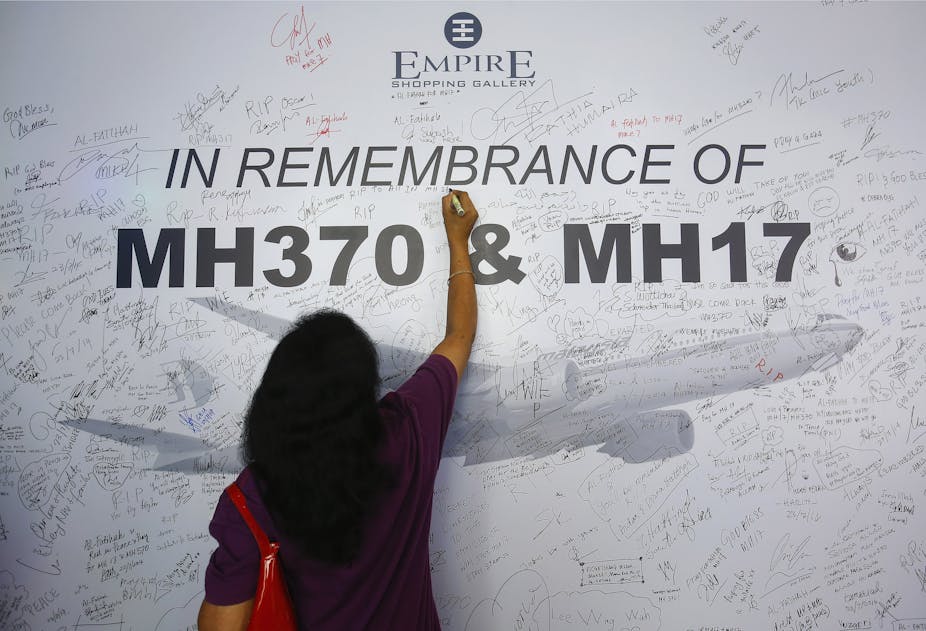The search for Malaysia Airlines (MH) flight 370 - which disappeared in March 2014 while flying from Kuala Lumpur to Beijing - has been a collaborative effort in all but one way.
Despite an agreement with Malaysia and China to share costs, Australia has carried the heaviest weight, with Australia’s 2014-1015 costs budgeted at $79.6 million, as against reported costs of $40 million incurred by the Malaysian government.
Australia has borne these search costs because it is the only state proximate to the area in which MH370 - it appears now - very likely ditched, and was practically the state best equipped to take the lead and conduct the search. Although 153 people of the 227 passengers and 12 crew onboard were Chinese, China did not contribute resources or equipment to the underwater search.
This situation has come about despite a raft of treaties signed by almost all the world’s nations in other areas such as liability for passenger death or injury, as well as for delay and loss of or damage to baggage and cargo (the 1929 Warsaw Convention and the 1999 Montreal Convention), and the 1944 Chicago Convention on international civil aviation.
Sharing the search costs more fairly
How, then, to arrive at a collaborative solution for future aviation search cooperation for recovery operations in non-territorial ocean waters? It seems to us that there are two possible solutions: one a multilateral approach, and the other a government-to-government approach.
In terms of a multilateral solution, Australia has taken the lead, in part because of bearing the search costs associated with MH370. Earlier this year, Australia suggested to ICAO at its Planning for Global Aviation Safety Improvement conference that an international approach be taken “to ensure that states allocate appropriate resources and prioritize [search] … activities similarly”.
An ICAO working paper from that conference states that
there is a high likelihood of problems arising in the continuity of a search that extends beyond the rescue phase. The potential for difficulties to arise is likely to exist in circumstances where the aircraft is believed to have gone missing in a search and rescue zone that is not the responsibility of the State with the onus to conduct the investigation … In the case of MH370 the aircraft was believed to have gone missing in Australia’s search and rescue zone but Malaysia had responsibility for the accident investigation under Annex 13.
The paper concluded that “in the event that a similar tragedy happens in the future, the states involved may be assisted by some additional [standards and recommended practices] that provide a framework for cooperation”.
A state-to-state approach
In the absence of any ICAO multilateral approach, we have argued that there may be some worth in concluding a state-to-state agreement between relevant states in the event of an accident. Such an agreement could incorporate the following six principles:
The state most proximate to the area in which an aircraft is lost would control the search and rescue operation and would fund that operation.
The state of registration/owners of the aircraft would be granted special status and consulted regarding the particulars of the search and rescue operation.
States with nationals on board the aircraft would be apprised of the parameters of the search on an ongoing basis, and would be invited to monitor that search (through physical representation or otherwise).
Reimbursement of costs incurred by the state controlling the search and rescue operation would be made at periodic intervals during the search (if lengthy) or at its conclusion, with (a) half of the costs borne equally by the state controlling the search and rescue operation and the state of registration/ aircraft owners, and (b) the remaining costs borne by states in proportion to the passengers on board.
If a state cannot afford its apportioned costs, those costs would be assumed by other states on the above basis.
The state most proximate to the area in which an aircraft is lost (in formal consultation with the state of registration/ aircraft owners), would determine when the search concludes.
It seems to us that, no matter whether a multilateral or state-to-state approach is taken, either approach may well afford a measure of certainty (and perhaps comfort) to relatives and friends of passengers.
That should be the objective of both ICAO and the airlines.

